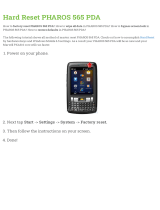
I
Contents
Contents ............................................................................................................... I
Chapter 1 Quick Start Guide ............................................................................... 1
1.1 Introduction .............................................................................................................. 1
1.2 Installation ............................................................................................................... 1
1.3 Before Login ............................................................................................................ 8
Chapter 2 Pharos Control Interface .................................................................... 9
2.1 Pharos Control Server ............................................................................................. 9
2.2 Pharos Control Client ............................................................................................. 11
2.2.1 Login ...............................................................................................................................11
2.2.2 Client Interface Overview................................................................................................12
2.2.3 Navigation .......................................................................................................................13
Chapter 3 Device ................................................................................................ 14
3.1 Device Classification .............................................................................................. 15
3.2 Device List ............................................................................................................. 17
3.3 Device Details ........................................................................................................ 27
Chapter 4 Firmware ............................................................................................ 38
4.1 Firmware Classification .......................................................................................... 38
4.2 Firmware List ......................................................................................................... 40
4.3 Firmware Details .................................................................................................... 41
Chapter 5 Task ................................................................................................... 43
5.1 Task Classification ................................................................................................. 44
5.2 Task List ................................................................................................................ 45
5.3 Task Details ........................................................................................................... 49
Chapter 6 Trigger ............................................................................................... 50
6.1 Trigger Rule and Event Classification .................................................................... 50
6.2 Trigger Rule/Event List .......................................................................................... 51
6.3 Trigger Rule/Event Details ..................................................................................... 54
Chapter 7 Account ............................................................................................. 56
7.1 Account Classification ............................................................................................ 57
7.2 Account List ........................................................................................................... 58
7.3 Account Details ...................................................................................................... 61

























